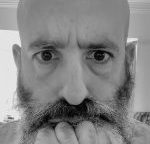We used to call the forms DNR, that is, ‘do not resuscitate,’ this was changed approximately 10 years ago into DNAR, then DNACPR – do not attempt cardiopulmonary resuscitation; the reasons for the change of mnemonic related to confusion over what do to if someone say, chokes:
If one of my patients (who has such a form completed) is sitting enjoying their breakfast and a slice of toast goes down the wrong way, and, they turn blue, the right thing to do is Heimlich; not walk away or, if someone is in pain, injured or hurt – this doesn’t mean don’t help, treat or support;
It is far narrower than that initial definition.
The new term says, if my heart stops – it either fibrillates – that is the wavy lines you see on the monitor, it flat-lines or, there remains electrical activity but there is no blood flow, then, in these circumstances, let me be.
Don’t defibrillate, batter my chest or force oxygen into my lungs. By all means, stay by my side, hold my hand, make sure I am comfortable, and, that is enough. No more.
The numbers of people who have these forms today has increased significantly over recent years, and in nearly all instances, they are appropriate – they avoid people having ineffective, degrading treatment – they allow for a natural passing-away, they save nursing and medical teams the trauma of engaging in a practice they know is futile but lack direction or experience to stop.
I don’t know the situation outside of Yorkshire and Humber – here, we have the one form, that follows a person from hospital home and if required back again; for, you see, DNACPR doesn’t mean don’t treat – it is not an instruction to stop the antibiotics or remove the oxygen; it is not palliation. Indeed, in many instances, it is the very opposite, it is the taking time to think and consider the reality of an individual’s existence and the likelihood of their death and frequent impossibility of recovery.
The form however is not enough;
I don’t intend to go into the details here as to how, when and who should complete the form – there are guidelines from the Resuscitation Council UK and other organisations.
What for me is the important association between the form and what happens to the person identified, is how we recognise that they are in the last year or months of life, that the added benefits of medical intervention – of which there are many, equal the costs of treatment, which are potentially, prolongation of death, extension of suffering, fear, hunger, pain.
If I had the option of 48 hours of pain and suffering beyond a potential passing-away, would I opt for this over leaving me be?
And, my point?
Well, it is, that DNACPR is not enough.
A form is not enough.
It is often perceived that so long as there is a form in the medical notes or resting on the mantelpiece, all will be well.
It is not so easy.
Over the past fifty years we have drifted far away from natural death into a realm of high-tech intervention, treatment and physiological support; for the most part this is incredible, often unbelievable in the wizardry of the technicians and scientists who have developed life enhancing and prolonging procedures and tools.
Yet, with this great gift, has been a departure from nature.
The medicalisation of death has become dominant.
In most places in the UK, the majority of people die in hospital beds. Away from home, from the familiar.
Many die in ambulances en route to A&E; the form is not adequately sophisticated to communicate the wishes of the individual in relation to the moments before the slipping-away; the system too complex to allow the obvious to take control.
Where am I going with this?
I am heading towards a recognition that the form is not enough; a piece of paper does not ensure a natural death; more is required. The conversation and explanation of process, a preparing for eventualities that are alien to the average person.
Yes, the form is the first-step, yet without complete consideration of all that might happen, go-on, the chances of failure are high and, with only one death allotted to each of us, we don’t want that to go wrong; like life, as Kundera says, there is no dress rehearsal.
For more see – advance care plan.


